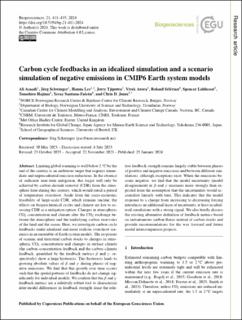| dc.contributor.author | Asaadi, Ali | |
| dc.contributor.author | Schwinger, Jörg | |
| dc.contributor.author | Lee, Hanna | |
| dc.contributor.author | Tjiputra, Jerry | |
| dc.contributor.author | Arora, Vivek K. | |
| dc.contributor.author | Séférian, Roland | |
| dc.contributor.author | Liddicoat, Spencer | |
| dc.contributor.author | Hajima, Tomohiro | |
| dc.contributor.author | Santana-Falcòn, Yeray | |
| dc.contributor.author | Jones, Chris D. | |
| dc.date.accessioned | 2024-04-25T08:22:19Z | |
| dc.date.available | 2024-04-25T08:22:19Z | |
| dc.date.created | 2024-01-25T10:04:43Z | |
| dc.date.issued | 2024 | |
| dc.identifier.citation | Biogeosciences. 2024, 21 (2), 411-435. | en_US |
| dc.identifier.issn | 1726-4170 | |
| dc.identifier.uri | https://hdl.handle.net/11250/3128044 | |
| dc.description.abstract | Limiting global warming to well below 2 ∘C by the end of the century is an ambitious target that requires immediate and unprecedented emission reductions. In the absence of sufficient near-term mitigation, this target will only be achieved by carbon dioxide removal (CDR) from the atmosphere later during this century, which would entail a period of temperature overshoot. Aside from the socio-economic feasibility of large-scale CDR, which remains unclear, the effects on biogeochemical cycles and climate are key to assessing CDR as a mitigation option. Changes in atmospheric CO2 concentration and climate alter the CO2 exchange between the atmosphere and the underlying carbon reservoirs of the land and the ocean. Here, we investigate carbon cycle feedbacks under idealized and more realistic overshoot scenarios in an ensemble of Earth system models. The responses of oceanic and terrestrial carbon stocks to changes in atmospheric CO2 concentration and changes in surface climate (the carbon–concentration feedback and the carbon–climate feedback, quantified by the feedback metrics β and γ, respectively) show a large hysteresis. This hysteresis leads to growing absolute values of β and γ during phases of negative emissions. We find that this growth over time occurs such that the spatial patterns of feedbacks do not change significantly for individual models. We confirm that the β and γ feedback metrics are a relatively robust tool to characterize inter-model differences in feedback strength since the relative feedback strength remains largely stable between phases of positive and negative emissions and between different simulations, although exceptions exist. When the emissions become negative, we find that the model uncertainty (model disagreement) in β and γ increases more strongly than expected from the assumption that the uncertainties would accumulate linearly with time. This indicates that the model response to a change from increasing to decreasing forcing introduces an additional layer of uncertainty, at least in idealized simulations with a strong signal. We also briefly discuss the existing alternative definition of feedback metrics based on instantaneous carbon fluxes instead of carbon stocks and provide recommendations for the way forward and future model intercomparison projects. | en_US |
| dc.language.iso | eng | en_US |
| dc.publisher | Copernicus Publications | en_US |
| dc.rights | Navngivelse 4.0 Internasjonal | * |
| dc.rights.uri | http://creativecommons.org/licenses/by/4.0/deed.no | * |
| dc.title | Carbon cycle feedbacks in an idealized simulation and a scenario simulation of negative emissions in CMIP6 Earth system models | en_US |
| dc.title.alternative | Carbon cycle feedbacks in an idealized simulation and a scenario simulation of negative emissions in CMIP6 Earth system models | en_US |
| dc.type | Journal article | en_US |
| dc.type | Peer reviewed | en_US |
| dc.description.version | publishedVersion | en_US |
| dc.source.pagenumber | 411-435 | en_US |
| dc.source.volume | 21 | en_US |
| dc.source.journal | Biogeosciences | en_US |
| dc.source.issue | 2 | en_US |
| dc.identifier.doi | 10.5194/bg-21-411-2024 | |
| dc.identifier.cristin | 2234218 | |
| dc.relation.project | EU – Horisont Europa (EC/HEU): 101056939 | en_US |
| dc.relation.project | Norges forskningsråd: 294930 | en_US |
| dc.relation.project | Sigma2: nn10054k | en_US |
| dc.relation.project | Sigma2: ns10054k | en_US |
| cristin.ispublished | true | |
| cristin.fulltext | original | |
| cristin.qualitycode | 1 | |

